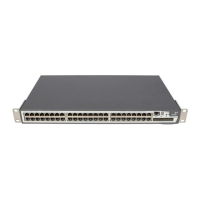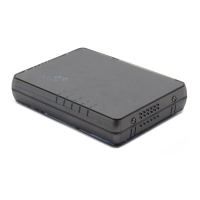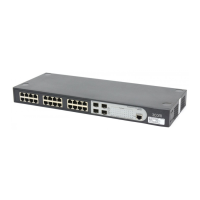OSPF Configuration Commands 197
To view brief information for every peer, enter the following:
<SW5500>display ospf peer brief
OSPF Process 1 with Router ID 1.1.1.1
Neighbor Statistics
Area ID Down Attempt Init 2-Way ExStart Exchange Loading Full Total
0.0.0.0 0 0 0 0 0 0 0 1 1
0.0.0.1 0 0 0 0 0 0 0 1 1
Total 0 0 0 0 0 0 0 2 2
display ospf
request-queue
Syntax
display ospf [
process-id
] request-queue
Mode Master/Slave mode formed by negotiation in exchanging DD packet
Priority Priority of DR/BDR for neighbor election
DR IP address of the interface of elected DR
BDR IP address of the interface of elected BDR
Dead timer expires in
31 seconds
If no hello packet received from the peer within this interval, the peer
will be considered to be invalid.
Neighbor has been up
for 01:14:14
Time of neighbor connection
Table 35 Output Description of the display ospf peer brief Command
Field Description
Area ID Area ID
Down The initial state for OSPF to establish neighbor relation, which indicates that
the OSPF router has not received the message from a certain neighbor router
within a period of time.
Attempt Enabled in the NBMA environment, such as Frame Relay, X.25 or ATM. It
indicates that OSPF router has not received the message from a certain
neighbor router within a period of time, but still attempts to send a Hello
packet to the adjacent routers for their communications with a lower
frequency.
Init Indicates that the OSPF router has received a Hello packet from a neighbor
router, but its IP address is not contained in the Hello packet. Therefore, a
two-way communication between them has not been established.
2-Way It indicates that a two-way communication between an OSPF router and a
neighbor router has been established. DR and BDR can be selected in this state
(or higher state)
ExStart In this state, the router determines the sequence number of the initial
database description (DD) packet used for data exchange, so that it can obtain
the latest link state information.
Exchange Indicates that the OSPF router sends DD packets to its neighbor routers to
exchange link state information.
Loading In this state, OSPF router requests routes from the neighbor based on the
updated link state information from neighbor routers and its expired
information, and waits for response from neighbor routers.
Full Indicates that database synchronization between the routers has been
completed, and their link state databases are consistent.
Table 34 Output Description of the display ospf peer Command
Field Description

